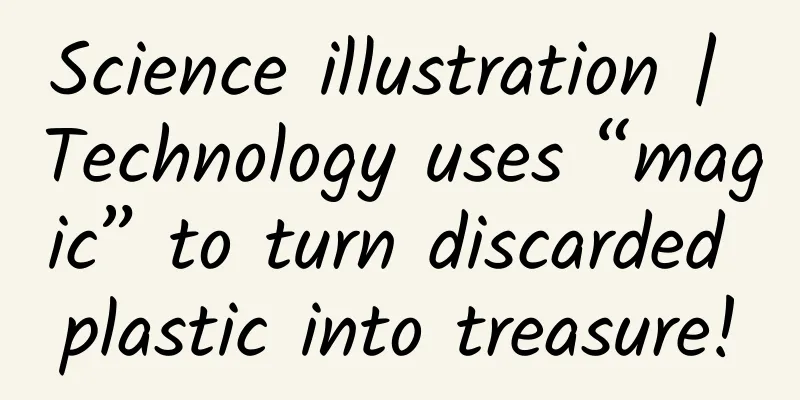Missed the Nobel Prize because I listened too much to the experts丨Virus Super Topic

|
To obey the law without changing it is to be perverse. - "Lüshi Chunqiu" Written by Jiang Yanjun and Li Qingchao (Shandong Normal University) Figure 1. Still life of tulips by Hans Bollongier in the mid-17th century. The striped tulips are called "Semper Augustus". Hans Gillisz. Bollongier, Flower Piece, Rijksmuseum, 1639. | Source: wikipedia In the 17th century, during the first economic bubble in human history, striped tulips were sought after by investors. At that time, a tulip bulb like the one in the picture above could easily cost thousands of Dutch guilders, which was equivalent to a worker's income for more than ten years. This was the so-called "Tulip mania". Now we know that this rare stripe is caused by infection with the "Tulip breaking virus" (TBV). In fact, the first virus discovered by humans was a plant-infecting virus called tobacco mosaic virus (TMV), which is a milestone in human exploration of microorganisms. one Missing In 1879, German plant pathologist Adolf Mayer began to study a tobacco disease. This disease can cause tobacco leaves to present irregular patterns of dark green and light green, and also cause them to wither and wrinkle, leading to a reduction in tobacco production. Based on the damage characteristics of the diseased tobacco, Mayer called this disease "tobacco mosaic disease" (translated into Chinese as "tobacco mosaic disease") and believed that it was caused by a certain pathogen. Figure 2. (Left) Diseased tobacco leaves; (Right) Adolf Mayer (1843-1942) | Source: Wikipedia Microbiology was experiencing a golden age of rapid development at this time. Robert Koch, a German scientist who discovered the bacteria that cause anthrax, tuberculosis, and cholera, was a key figure in this era. He perfected and published the famous "Koch's Postulates" in 1890 to establish the exact relationship between pathogens and diseases. The content is as follows: 1. A certain microorganism is present in all individuals with a certain disease but is not present in healthy individuals. 2. The microorganism must be isolated from the diseased individual and grown in pure culture in the laboratory. 3. The microorganism grown in the laboratory must cause the same disease when inoculated into a healthy individual. 4. The microorganism must be re-isolated from individuals who become ill after inoculation. Figure 3. "Koch's Postulates" was proposed by German bacteriologist F. Loeffler based on Koch's report. Its core content is the criterion for proving the causal relationship between pathogens and diseases. Source | Kaufmann SHE (2021). Vaccine Development Against Tuberculosis Over the Last 140 Years: Failure as Part of Success. Frontiers in microbiology, 12, 750124. If the above criteria are met, it can be proved that the microorganism causes the disease. Using Koch's postulates, people have identified many pathogenic microorganisms. Mayer also followed this idea when studying tobacco diseases. Through a key experiment, Mayer proved that mosaic disease is contagious: crush the diseased leaves and soak them in water to obtain a green suspension, and then use a glass capillary to suck a small amount of juice and inject it into the veins of healthy tobacco plants. After a period of time, 9 out of 10 injected plants showed the same mosaic lesions. This fully proves that the juice made by crushing the diseased leaves is contagious. However, Mayer did not find bacteria in the juice. He tried to filter out the bacteria in the juice with filter paper, but the filtered juice was still pathogenic. At that time, the technology for filtering leaf juice was limited, and it only relied on filter paper for coarse filtration. Therefore, he insisted that the microorganism that caused the plant disease was a very small bacteria that was invisible under a microscope, and asserted that pure juice without the pathogen could be obtained by multiple filtrations. two Missed opportunity It was not until 1884 that Charles Chamberland, an assistant to French scientist Pasteur, invented a ceramic filter that could filter out the smallest pathogens known at the time, namely bacteria, called the Chamberland filter. With this filter that can filter out bacteria, people can compare the pathogenicity of extracts from diseased individuals containing bacteria and extracts without bacteria, thereby studying bacterial infectious diseases and bacterial toxins. Figure 4. Chamberlain filter, which was believed to be able to filter out bacteria. Source: Wikipedia In 1887, when Russian botanist Dmitri Ivanovsky was studying tobacco mosaic disease in Crimea, he filtered the juice of diseased leaves through a bacterial filter made of porous ceramics, and then applied the filtered juice to healthy tobacco leaves, only to find that the healthy leaves also showed a mottled yellow color similar to the diseased leaves. This result shows that the pathogen of this disease can pass through the bacterial filter, suggesting that tobacco mosaic disease may not be caused by the bacteria that people are familiar with. However, adhering to the spirit of rigor and pragmatism, Iwanowski still proposed in an article published in 1892 that tobacco mosaic disease is caused by some filterable bacteria or toxins secreted by them. After all, there is always the possibility that there are smaller bacteria in the world, so small that even the Chamberlain filter cannot filter it out! Iwanowski's experimental results aroused the interest of many scientists. A Dutch microbiologist named Martinus Beijerinck (Figure 6) independently conducted an experiment almost identical to Iwanowski's, but he also smeared tobacco juice filtered through a ceramic filter on agar (agar is a common reagent for the preparation of microbial solid culture media, similar to jelly and grass jelly ingredients). After a while, he found that this mysterious pathogenic substance could actually diffuse into agar. Generally speaking, bacteria can only grow on the surface of agar solid culture media to form colonies, and rarely diffuse into the interior of the solid culture media. Of course, bacterial toxins can also diffuse in agar, so this pathogenic substance is either a new pathogen or a toxin. Figure 4. Iwanowski's experimental process, Beijerinck added agar, and the pathogen can still infect the leaves after spreading in the agar | Author's drawing At the same time, Beijerinck also filtered the juice of the infected leaf (leaf ② in the picture) and applied it to another healthy plant, and found that the healthy plant could also become sick. This shows that the new healthy leaves are infected, not poisoned (contacted with toxins), because only pathogens can multiply and continuously infect new leaves, while the amount of toxins is limited and will be diluted and disappear. In summary, this is a mysterious organism that can spread without weakening its pathogenicity and seems to reproduce only in the leaves. Once it leaves the tobacco leaves, it seems to disappear. In 1898, Beijerinck published his discovery and referred to this new infectious, liquid-like pathogen that can remain active after filtration as "virus", an abbreviation of the Latin phrase "contagium vivum fluidum". As the first scientist to propose the concept of "virus", Beijerinck's work laid the foundation for virology. Although he mistakenly believed that viruses were "venomous" (but they were actually particles). However, at that time, his experimental conclusions seemed too radical and conflicted with the early germ theory, so his views were not generally recognized and even criticized by previous researchers Iwanowski. “The issue has long been settled,” Iwanowski said. Figure 5. (Left) Dmitri Ivanovsky (1864-1920); (Right) Martinus Beijerinck (1851-1931) | Source: Wikipedia three The True Face of Mount Lu Obviously, once the opinion of a great man is fully affirmed, its status will be difficult to shake easily. In the field of microbiology at that time, the research rules proposed by Koch had a supreme status like gold, but also became a shackle on the heads of scientists. In fact, during this period, when studying other diseases, many scientists' experimental conclusions seemed to stand on Beijerinck's side. However, due to the inability to directly observe filterable pathogens using a microscope, many diseases related to filterable pathogens discovered in the 1920s could not be accurately determined. Whether the pathogens of such diseases are microscopic bacteria, bacterial secretions, or other substances, and what the nature of this filterable pathogen is, there is still no reliable answer. "The virus is still holding back, unwilling to show its true face to the world. It was not until 1935 that Beijerinck's conjecture was finally confirmed by American chemist Wendell M. Stanley. Stanley believed that the filterable pathogen on tobacco leaves might be a protein molecule, and first observed virus crystals separated from the juice of diseased leaves through X-ray diffraction (in fact, the clearest X-ray diffraction image of tobacco mosaic virus was obtained by Rosalind Franklin, who discovered the double helix structure of DNA. This female scientist is really extraordinary). At the same time, he learned that the crystals also contained nucleic acid components, and this discovery won him the Nobel Prize in Chemistry in 1946. In 1941, with the advent of the electron microscope, people finally obtained the first photo showing the morphological structure of tobacco mosaic virus (Figure 6), and this thin, stick-shaped virus was finally revealed. Figure 6. Tobacco mosaic virus under an electron microscope | Source: Wikipedia Tobacco mosaic virus (TMV) is a single-stranded RNA virus (Figure 7). It is the pathogen of plant diseases such as tobacco mosaic disease and belongs to the Tobamovirus group. The TMV virion is a straight rod-shaped virus, about 300 nanometers long and 15 nanometers in diameter, with a single-stranded positive-sense RNA (+ssRNA) genome of about 6400 bases. The 3' end of the TMV genomic RNA has a tRNA-like structure and the 5' end has a methylated nucleotide cap. Figure 7. Schematic diagram of the structure of tobacco mosaic virus. Tobacco mosaic virus is a rod-shaped virus③, generally 300nm long and 18nm in diameter, consisting of an outer capsid② and an inner single-stranded RNA①. Source | Thomas Splettstoesser (www.scistyle.com) The TMV genome encodes four open reading frames (ORFs), two of which produce only one protein molecule due to ribosome read-through. These four genes encode replicase (containing methyltransferase [MT] and RNA helicase [Hel] domains), RNA-dependent RNA polymerase, viral movement protein (MP) and capsid protein (CP). The nucleic acid is wrapped by a capsid composed of 2130 protein subunits. The capsid is a rod-shaped helical structure formed by the self-assembly of capsid proteins, which constitutes the rod-shaped appearance of tobacco mosaic virus.
Tobacco mosaic virus (TMV) infects plants, mainly tobacco, an economic crop, causing huge economic losses. The prevention and control of tobacco mosaic disease also focuses on tobacco plants, strengthening tobacco plant health cultivation, cutting off the transmission route, emphasizing resistance induction and taking chemical agents as auxiliary. But in fact, TMV has a very wide host range and is known to be infectious to 198 species of plants in 22 families of monocots. TMV has different strains, and my country mainly has four strains: common strain, tomato strain, yellow spot strain, and pearl spot strain. They have different pathogenicity and cause different symptoms; the symptoms caused by co-infection with other viruses are also diverse. Figure 11 In addition to infecting tobacco, tobacco mosaic virus can also infect Solanaceae flowers, vegetables, and nearly 200 plant species. Source | TMV is mainly transmitted through sap. When the leaves are slightly rubbed and cause micro-wounds, it invades the leaf cells, reproduces in the thin-walled cells, and then enters the vascular tissue to infect the entire plant. At the same time, insects with chewing mouthparts such as locusts and tobacco budworms in tobacco fields can also spread TMV. TMV is an extremely stable virus with strong pathogenicity and environmental resistance. It can survive in dry tobacco leaves for up to 52 years and still be infectious after being diluted 1 million times. On dry leaves, it can withstand temperatures as high as 50°C for 30 minutes. Therefore, if planters working in greenhouses smoke on a regular basis, it may pose a threat to greenhouse plants. However, it is precisely because TMV is so stable that people were able to discover it. Four Monumental Tribute As the first virus discovered by humans, tobacco mosaic virus (TMV) has groundbreaking significance in the history of virology research. Similar to other microbiological studies, in the process of studying TMV virus, scientists have also obtained some extremely important conclusions for the development of life sciences. In the process of studying "what is the essence of genetic material", TMV tells us that RNA can also be genetic material. In 1936, Frederick Bawden of the Plant Pathology Department of the Rothamsted Agricultural Experiment Station in the UK and Norman Pirie of the Pathology Department of the University of Cambridge collaborated to test the tobacco mosaic virus crystals refined by the precipitation method and found that the nitrogen content in the crystals was 16.7%, the phosphorus content was 0.5%, and the sugar content was 2.5%. After in-depth research, they pointed out that tobacco mosaic virus is a nucleic acid protein complex composed of approximately 95% protein and 5% RNA. Although Bawden and Pirie proved that tobacco mosaic virus contained RNA, they did not find that RNA carried important genetic information as a genome. Bawden's disciple BD Harrison once mentioned in an article that Bawden and Pirie had tried to study whether RNA was contagious, but it may be because the two laboratories were 50 miles apart. When Pirie sent the isolated RNA to Bawden, the RNA had already been inactivated. Therefore, Bawden and Pirie failed to discover the infectivity of RNA and missed the important discovery of RNA as genetic material. (A reminder to all leaders: please create various conveniences for scientific researchers in their work and life). "TMV is a protein, and RNA is either a contaminant or plays a structural role," this was the inference of scientists at the time. It is well known that viruses can contain DNA (such as poxviruses, adenoviruses, etc.) or RNA (such as influenza viruses, coronaviruses, etc.). But for many years, people have always believed that the genome is composed only of DNA (transformation experiments on pneumococci in 1944, T2 phage experiments in 1952). There is only RNA in tobacco mosaic virus? Obviously "something went wrong." Finally, 20 years later, in 1956, German scientists Alfred Gierer and Gerhard Schramm discovered that RNA has the ability to infect. They shook TMV in water and phenol to separate RNA from protein, and then used the purified RNA to inoculate tobacco. As a result, typical mosaic lesions appeared on tobacco leaves. However, when RNA was treated with ribonucleases to decompose RNA and then inoculated into tobacco, no lesions appeared on tobacco leaves. After a series of experimental verifications, Gierer and Schramm pointed out that the RNA component of tobacco mosaic virus can synthesize new tobacco mosaic virus in inoculated tobacco leaves, so RNA is a genetic material! The following year, German biochemist Heinz Fraenkel-Conrat and his wife Beatrice Singer further confirmed the above conclusions of Gierer and Schramm through virus reconstruction experiments (Figure 9). Figure 9. TMV viral RNA can produce new virus particles, but viral proteins cannot. The type of new virus particles produced after re-infection with recombinant virus particles depends on the type of nucleic acid in the recombinant virus. Source | five If you don't change, you will be in trouble. "Lüshi Chunqiu·Lan·Shen Da Lan" says: "If a country is governed without laws, it will be in chaos; if it abides by the laws but does not change, it will be perverse; perverse and chaotic cannot sustain a country." Governing a country without a certain legal system will lead to chaos; if it clings to the old laws without knowing how to change, it will also lead to chaos. Scientific research is also such a constantly changing process: it is necessary to establish viewpoints to reveal the truth, but it also emphasizes correcting or even overthrowing old or wrong viewpoints. Koch's postulates played an indelible guiding role in early etiology research, but they also became a "spiritual shackle" for some people. "Koch's Postulates" is not a law or rule, but four "assumptions" that are the conditions that need to be met to determine whether a microorganism is a pathogen. In fact, the characteristics of many pathogens do not fully meet the conditions required by Koch's postulates. For example, Vibrio cholerae also exists in healthy people, which violates the first article of the original Koch's postulates; HIV cannot be cultured independently in vitro (it needs to replicate in living cells), which does not meet the second article of Koch's postulates. Until the 1980s, the "fundamentalists" of Koch's postulates were still using the oldest version of Koch's postulates to question the existence of HIV and the relationship between Helicobacter pylori and gastric ulcers. But this cannot be blamed on Koch, because he himself later discovered asymptomatic carriers infected with cholera or typhoid fever, thereby amending the strict requirement of the first law that "the microorganism does not exist in healthy individuals." With the continuous development of science and technology, modern biotechnology marked by the discovery of DNA structure has brought about tremendous changes in the face of etiology research. American microbiologist Stanley Falkow proposed the "Molecular Koch's postulates" based on the molecular evidence of "virulence factors" causing disease. In 1996, David Fredricks and David Relman established a molecular guide to the causal relationship between microorganisms and diseases containing seven contents. The core of these theories is to discover molecular evidence of pathogens related to disease. In this new crown epidemic, less than two weeks after the "unexplained pneumonia" appeared, scientists discovered that its pathogen was the new coronavirus SARS-CoV-2, which is a successful practice of etiology research "using viral genome sequences as key evidence". References 1. Liu Shanshan. Pathogen analysis of tobacco virus diseases in some tobacco-growing areas in my country [A]. Chinese Society of Plant Pathology. Proceedings of the 2017 Annual Meeting of the Chinese Society of Plant Pathology [C]. Chinese Society of Plant Pathology: Chinese Society of Plant Pathology, 2017: 1. 2. Tobacco mosaic virus | plant virus | Britannica. www.britannica.com/ 3. Fu Yifeng. Research progress on tobacco mosaic virus disease[J]. Beijing Agriculture, 2015(12):115-117. 4. Feng Changquan. Reconstruction experiment of tobacco mosaic virus (TMV). Bulletin of Biology, 1990:1 5. Li Siguang, Wu Xiangjun, Chen Dijun, He Rong, Ding Wei. Prevention and control measures for tobacco common mosaic virus disease[J]. Plant Doctor, 2015, 28(05): 44-45. 6. Wang Yongchong. Introduction to the classification of crop diseases and pests and their control atlas - tobacco mosaic virus disease and its control atlas [J]. Pesticide Market Information, 2018(23):58. 7. Zhai Yujun, Liu Honghai, Li Xingliang, Huang Wei, Ni Qifeng. Research progress of tobacco virus detection technology[J]. Agricultural Products Processing (Academic Journal), 2009(04):83-88. 8. Yang Fang. Field efficacy evaluation of several virus inhibitors for the control of tobacco mosaic virus disease[A]. Chinese Society of Plant Protection. Green plant protection and rural revitalization - Proceedings of the 2018 Annual Conference of the Chinese Society of Plant Protection[C]. Chinese Society of Plant Protection: Chinese Society of Plant Protection, 2018:3. 9. Wu Feng, Lü Qi, Yuan Hang, Tan Zhongxia, Qin Xiyun, Xia Zhenyuan, Mo Xiaohan, Ma Lan. Establishment and application of rapid detection method for tobacco mosaic virus[J]. Journal of Yunnan University (Natural Science Edition), 2012, 34(S1):110-115+121. 10. Mayer A (1886). "Über die Mosaikkrankheit des Tabaks". Die Landwirtschaftliche Versuchs-stationen (in German). 32: 451–467. Translated into English in Johnson, J., Ed. (1942) Phytopathological classics (St. Paul, Minnesota: American Phytopathological Society) No. 7, pp. 11–24. 11. Zaitlin M (1998). "The Discovery of the Causal Agent of the Tobacco Mosaic Disease" (https://www.apsnet.org/edcente r/apsnetfeatures/Documents/1998/ZaitlinDiscoveryCausalAgentTobaccoMosaicVirus.pdf) (PDF). In Kung SD, Yang SF (eds.). Discoveries in Plant Biology. Hong Kong: World Publishing Co. pp. 105–110. ISBN 978-981-02-1313-8. 12. Iwanowski D (1892). "Über die Mosaikkrankheit der Tabakspflanze". Bulletin Scientifique Publié Par l'Académie Impériale des Sciences de Saint-Pétersbourg / Nouvelle Serie III (in German and Russian). 35: 67–70. Translated into English in Johnson, J., Ed. (1942) Phytopathological classics (St. Paul, Minnesota: American Phytopathological Society) No. 7, pp. 27–30. 13. Iwanowski D (1903). "Über die Mosaikkrankheit der Tabakspflanze". Zeitschrift für Pflanzenkrankheiten und Pflanzenschutz (in German). 13(1): 1–41. 14. Beijerinck MW (1898). "Über ein Contagium vivum fluidum als Ursache der Fleckenkrankheit der Tabaksblätter" (http s://www.dwc.knaw.nl/DL/publications/PU00011860.pdf) (PDF). Verhandelingen der Koninklijke Akademie van Wetenschappen Te Amsterdam (in German). 65: 1–22. Translated into English in Johnson, J., Ed. (1942) Phytopathological classics. (St. Paul, Minnesota: American Phytopathological Society) No. 7, pp. 33–52 (St. Paul, Minnesota) 15. "Wendell M. Stanley – Biographical" (http://nobelprize.org/nobel_prizes/chemistry/laureates/1946/stanley-bio.html). nobelprize.org. 16. "The Nobel Prize in Chemistry 1946" (https://www.nobelpriz/ e.org/prizes/chemistry/1946/summary/). NobelPrize.org. Retrieved 2019-12-03. 17. Kay LE (September 1986). "WM Stanley's crystallization of the tobacco mosaic virus, 1930–1940". Isis; an International Review Devoted to the History of Science and Its Cultural Influences. 77 (288): 450–72. doi:10.1086/354205 (https://doi.org/10.1086%2F354205). JSTOR 231608 (https://www.jst/ or.org/stable/231608). PMID 3533840 (https://pubmed.ncbi/.nlm.nih.gov/3533840). 18. Kausche GA, Pfankuch E, Ruska H (May 1939). "Die Sichtbarmachung von pflanzlichem Virus im Übermikroskop". Naturwissenschaften. 27 (18): 292–9. Bibcode:1939NW....27..292K (https://ui.adsabs.harvard.edu/ abs/1939NW....27..292K). doi:10.1007/BF01493353 (https://doi.org/10.1007%2FBF01493353). S2CID 206795712 (http s://api.semanticscholar.org/CorpusID:206795712). 19. Maddox B (2002). Rosalind Franklin, the Dark Lady of DNA (https://archive.org/details/rosalindfranklin00madd). Harper Collins. ISBN 978-0-06-018407-0. 20. Zaitlin M (1984). Brunt AA, Crabtree K, Dallwitz MJ, Gibbs AJ, Watson L, Zurcher EJ (eds.). "Tobacco mosaic tobamovirus" (https://web.archive.org/web/2009100100545 2/http://www.agls.uidaho.edu/ebi/vdie/descr803.htm). Plant Viruses Online: Descriptions and Lists from the VIDE Database. Archived from the original (http://www.agls.uidah/ o.edu/ebi/vdie/descr803.htm) on 2009-10-01. 21. Stryer L (1988). Biochemistry (https://archive.org/details/bio chemistry3rdedi00stry). San Francisco: WH Freeman. ISBN 978-0-7167-1843-7. 13. Klug A (March 1999). "The tobacco mosaic virus particle: structure and assembly" (https://www.ncbi.nlm.nih.gov/pmc/articles/PMC1692534). Philosophical Transactions of the Royal Society of London. Series B, Biological Sciences. 354 (1383): 531–5. doi:10.1098/rstb.1999.0404 (https://doi.org/10.1098%2Frstb.1999.0404). PMC 1692534 (https://www.ncb/ i.nlm.nih.gov/pmc/articles/PMC1692534). PMID 10212932 (ht tps://pubmed.ncbi.nlm.nih.gov/10212932). 22. PDB: 1VTM (https://www.rcsb.org/structure/1VTM); Namba K, Stubbs G (March 1986). "Structure of tobacco mosaic virus at 3.6 A resolution: implications for assembly". Science. 231 (4744): 1401–6. doi:10.1126/science.3952490 (https://do i.org/10.1126%2Fscience.3952490). PMID 3952490 (https://pubmed.ncbi.nlm.nih.gov/3952490). 23. Goelet P, Lomonossoff GP, Butler PJ, Akam ME, Gait MJ, Karn J (October 1982). "Nucleotide sequence of tobacco mosaic virus RNA" (https://www.ncbi.nlm.nih.gov/pmc/articl es/PMC347001). Proceedings of the National Academy of Sciences of the United States of America. 79 (19): 5818–22. Bibcode:1982PNAS...79.5818G (https://ui.adsabs.harvard.ed/u/abs/1982PNAS...79.5818G). doi:10.1073/pnas.79.19.5818 (h ttps://doi.org/10.1073%2Fpnas.79.19.5818). PMC 347001 (http://www.ncbi.nlm.nih.gov/pmc/articles/PMC347001). PMID 6964389 (https://pubmed.ncbi.nlm.nih.gov/6964389). 24. "Sequence: V01408.1" (https://www.ebi.ac.uk/ena/browser/view/V01408.1). European Nucleotide Archive. EMBL- EBI. Retrieved 28 March 2020. "International central site for archiving nucleic acid sequence. The reference standard in international science." 25. Expasy Viralzone Tobamovirus (http://viralzone.expasy.org/all_by_species/51.html) 26. Gergerich RC, Dolja VV (2006). "Introduction to Plant Viruses, the Invisible Foe". The Plant Health Instructor. doi:10.1094/PHI-I-2006-0414-01 (https://doi.org/10.1094%2 FPHI-I-2006-0414-01). 27. Agrios G (2005). Plant Pathology (5th ed.). Burlington, MA: Elsevier Academic Press. p. 320. ISBN 978-0-12-044565-3. 28. https://en.wikipedia.org/wiki/Molecular_Koch%27s_postulates This article is supported by the Science Popularization China Starry Sky Project Produced by: China Association for Science and Technology Department of Science Popularization Producer: China Science and Technology Press Co., Ltd., Beijing Zhongke Xinghe Culture Media Co., Ltd. Special Tips 1. Go to the "Featured Column" at the bottom of the menu of the "Fanpu" WeChat public account to read a series of popular science articles on different topics. 2. Fanpu provides a function to search articles by month. Follow the official account and reply with the four-digit year + month, such as "1903", to get the article index for March 2019, and so on. Copyright statement: Personal forwarding is welcome. Any form of media or organization is not allowed to reprint or excerpt without authorization. For reprint authorization, please contact the backstage of the "Fanpu" WeChat public account. |
<<: Summer is coming, it is a good time to enjoy the sun
>>: Some "whole wheat" breads are tricking you into gaining weight
Recommend
Building a reinforcement learning API based on TensorFlow: How was TensorForce created?
This article will be centered around a practical ...
Have you ever heard of an assassination that comes from the sky?
Introduction: Mysterious backs, silent assassinat...
Highlight the key points! All advertising resources in iQiyi’s information flow!
The latest data from iResearch MUT in April shows...
Replacing Android! Huawei's Hongmeng OS plans to adapt to Qualcomm platform
[[397905]] Not long ago, Huawei HarmonyOS's o...
A list of tea tasting studios in Nanjing, collect them now
Reservation arrangements for Nanjing audition clu...
Wang Chengshu: The "Three Plum Blossoms" in the Nuclear Physics Community
*Academician Wang Chengshu Memorial Hall The Nucl...
How to deploy DOU+ most effectively? Chen Jiangxiong: Douyin DOU+ high-end paid courses Baidu Netdisk (worth 9980)
If you chat with a stranger and say, "Brothe...
Staying up late to watch the game, how to take a nap? Huaxi doctors: Don't exceed this time, otherwise...
Let Dr. Huaxi take a look Which babies are there ...
Benefits for European Cup riders: Dongchedi launches "Hardcore rider carnival party"
In the summer of 2021, the European Cup, which wa...
After upgrading to 4G, which mobile phone has the fastest internet speed?
Of course not Xiaomi phones. Although Lei Jun’s s...
During the start of the school season, how can information flow advertising cleverly leverage marketing momentum?
When will the “longest winter vacation” in histor...
How to run a perfect event?
Just recently, the finals of the official King of...
This is the first time I have seen such a comprehensive information flow optimization case!
After reading this article, you will be able to i...
Product Analysis Report丨How does WeChat Reading retain users?
I have always believed that reading is a solitary...









